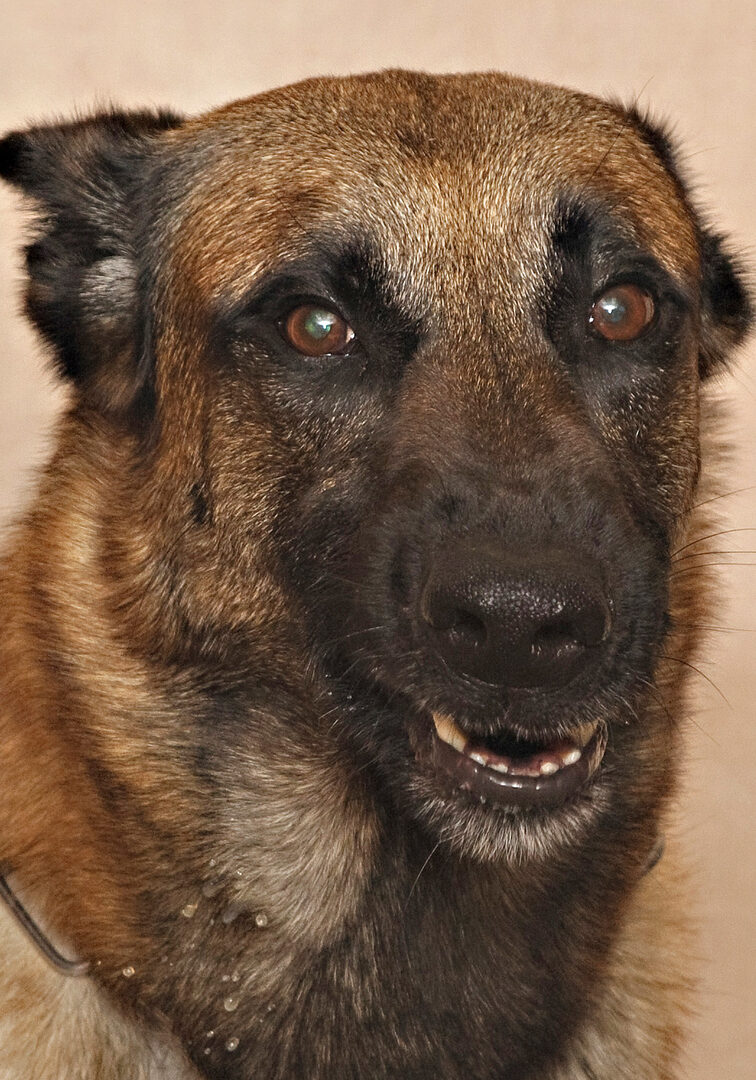





My Journey to Study Mood Contagion Between Dogs & Humans
How Elle Vom Bahnhof Launched My Career into Clinical & Comparative Psychology
When I returned to NW Pennsylvania to help with my mother when she had become ill, I dusted off my MS in Psychology from the University of Wisconsin - Madison and went into mental health. I soon surmised that a Ph.D. would be necessary to have any kind of meaningful impact in this field. Thus, I returned to school, and I needed to develop a dissertation topic. One day, I took a vacation day from work to stay home to complete a paper on mood contagion for my Social Psychology class, which was required in my Ph.D. program. On typical days when I would stay home, I would get up and soon go on a long run or hike with Elle.
On this day, I got up, and after taking Elle out for a brief bathroom break, as I would do on a typical workday, I came inside, remained in my pajamas, and worked feverishly on this paper. At about 300 PM, I began to feel very uncomfortable.
I thought, "Humm, I've made all manner of progress today, more than I had hoped for. I have had a very good time reading all of these papers and putting them together into a coherent form. Wonder why I feel so amazingly anxious?"
In my periphery, I noticed Elle sitting off to the side of my desk. I looked over at her, with her dark eyes piercing through me, ears out to the side, with a very distinctive look of being frustrated with me. All of a sudden, it hit me! The discovery of a lifetime.
Unconsciously, my emotional state was reacting to her emotional state. It was mood contagion, from canine to human. To me, this was a true landmark discovery, right up there with Newton being bonked on the head by an apple. Just like gravity is all around us, but we don't notice it, dogs' emotions surround many of us, and we don't notice them. Imagine the implications for health and mental health of this effect? Could this canine-to-human mood contagion be how dogs help us feel better and improve our health?
Thus, I started on my journey to study mood contagion between dogs and humans. It was all thanks to Elle, that special dog who taught me so much and whom I loved so much.
Being in psychology and having to please a committee full of psychologists, I had to start at the beginning with very solid scientific findings and build from there, much of the excellent work in examining how mood contagion works from human-to-human utilized Paul Ekman's photographs. His photographs of human faces depicting the "basic emotions" could be identified across cultures. If I just did this same thing with dogs, in a very objective, behaviorally anchored protocol, we could, for the first time, examine emotions across species, which had never been done in a controlled, scientific manner. Thus, my dissertation was born.
By the time I got around to actually taking the photographs (a committee full of psychologists can be very difficult to please), Elle was gone. Additionally, it was determined that a Doberman would not be a good subject for the photographs because of the bad press they often receive. Instead, we used my friend, the City of Franklin PA, Police Officer Kevin Anundston's Belgian Malinois, "Mal," for the photographs. I had helped Kevin locate Mal, who was purchased from Ivan Balabanov. I also helped Kevin with Mal's early training.
Initially, we thought a "wolf-like" dog would be the best subject for us to examine. However, after this study was complete, I read Adam Boyko's work on Village Dogs, and now I believe that a dog with more of a Village Dog appearance would be a better choice, which I will discuss in detail in my next paper.
Currently, Harris Friedman and I have a small grant to study more morphologies of dogs. We are using my Rhodesian Ridgeback, Kali, who has the Villiage Dog appearance, and Ginger vom Bahnhof (AKA "Katie," who is owned by Kevin Anundson) to see whether people are similar in their responses across these three morphologies of dogs. Currently, this study is in progress.
You can read my original paper at: http://www.sciencedirect.com/science/article/pii/S0376635713000326
For more a user-friendly version, take a look at:
You can find Paul Ekman's work at:
For more information on dogs, and how dogs can help rehabilitate traumatized people, please take a look at the following references:
Bloom, T. (2022). Review of: “Olfactory detection and discrimination in domestic dogs (Canis lupus familiaris).” BioRxiv. Qeios ID: K4JU1Q · https://doi.org/10.32388/K4JU1Q 1
Bloom, T. (2021). An Untold Story of Dogs: Clandestine Canine Contributions to Science. Society & Animals (published online ahead of print 2021). doi: [+https://doi.org/10.1163/15685306-BJA10048+](https://doi.org/10.1163/15685306-BJA10048)
Bloom, T., & Bradshaw, G. A. (2021). Inside of a prison: How a culture of punishment prevents rehabilitation. Peace and Conflict: Journal of Peace Psychology. Advance online publication. https://doi.org/10.1037/pac0000572(https://doi.apa.org/doi/10.1037/pac0000572)
Bloom, T., & Friedman, H. L. (2013). Classifying dogs’ (Canis familiaris) facial expressions from photographs._Behavioural Processes, 96, _1-10.
Bloom, T., & Friedman, H. L. (2014). The psychobiological and neurobiological implications of humans' ability to read emotions from facial expressions in dogs. In A. Freitas-Magalhães, (Ed.), Emotional expressions: The brain and the face (Volume 5, pp. 85-103.). Porto, Portugal: University Fernando Pessoa.
Bloom, T., Serrano, B. R., & Bradshaw, G. A. (2021). In the company of animals: Accompaniment transforms prisoners into colleagues, teachers, and healers. The Humanistic Psychologist, 49(4), 602-615_._ [+https://doi.org/10.1037/hum0000256+](https://doi.org/10.1037/hum0000256)
Bloom, T., Trevathan-Minnis, M., Atlas, N., MacDonald, D., Friedman, H. L. (2021). Identifying facial expressions in dogs: A replication and extension study. Behavioural Processes, 186, 104371. doi: [10.1016/j.beproc.2021.104371 ](https://doi.org/10.1016/j.beproc.2021.104371)
Bradshaw, G. A., & Bloom, T. (2020). Come to kale: Accompaniment across species and situations. The Humanistic Psychologist. Advance online publication. doi: 10.1037/hum0000211
Friedman, H., Bloom, T., & Trevathan-Minnis, M. (Eds.) (2021). Special issue on human-animal studies: Implications for humanistic psychology. The Humanistic Psychologist, 49(4).
Friedman, H. L., Bloom, T., & Trevathan-Minnis, M. (2021). Introduction to special section on human-animal studies: Humanistic psychology contributions of Team Woof. The Humanistic Psychologist, 49(4), 573-576.
Rendeiro (Bloom), T., Knapic, J., & Drews, F. (1987). Factors related to Exercise Adherence in Senior Military Officers. Report No. T-4-87. Army Physical Fitness Research Institute (APRFI), US Army War College (USAWC), Department of Defense, October, 1987.
Trevathan-Minnis, M., Bloom, T., Atlas, N., MacDonald, D. A., & Friedman, H. L. (2021). Using dog facial-emotion recognizability to explore the putative Black Dog Syndrome. The Humanistic Psychologist, 49(4), 616-629.
Whitely, K., Bloom, T., & Friedman, H. L. (2014). Criminal justice and its many injustices: Focus on prison psychology within the United States. In C. V. Johnson and H. L. Friedman (Eds.), The Praeger handbook of social justice and psychology (Vol. 1, pp. 241-268). Santa Barbara, CA: Praeger.










